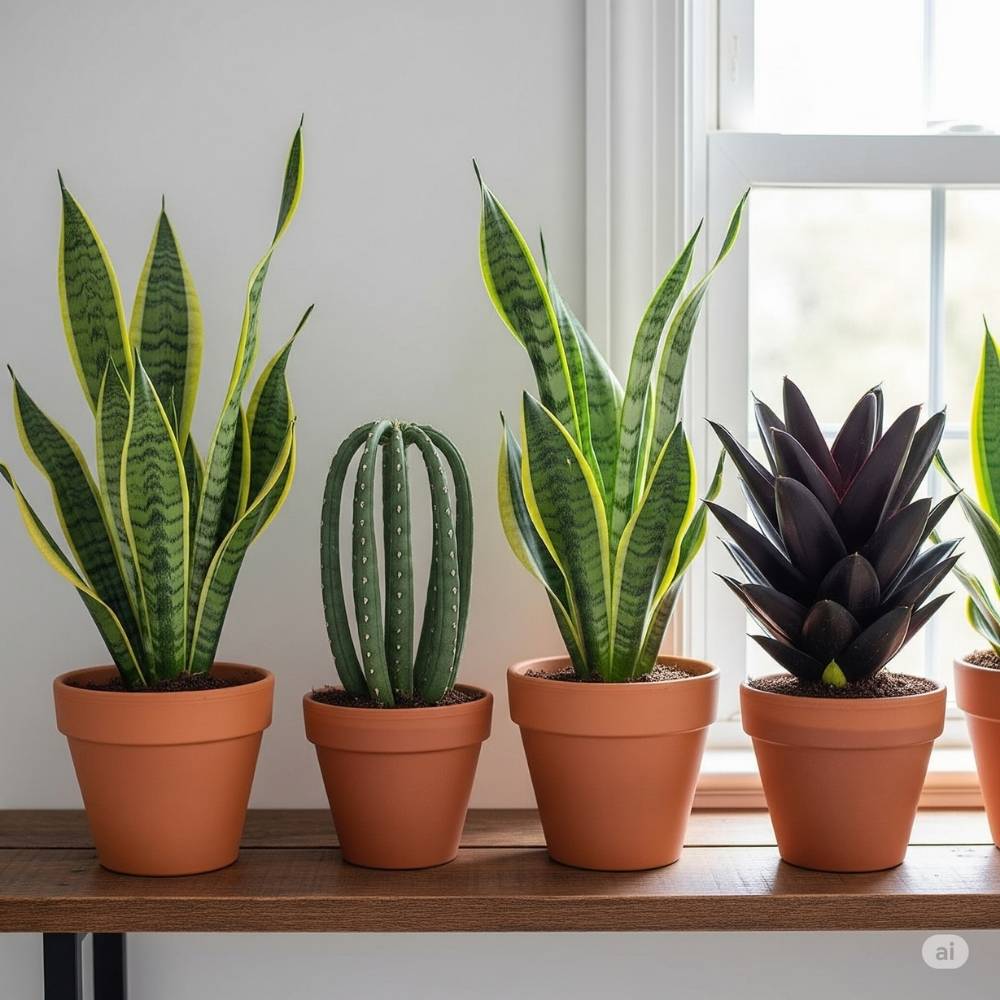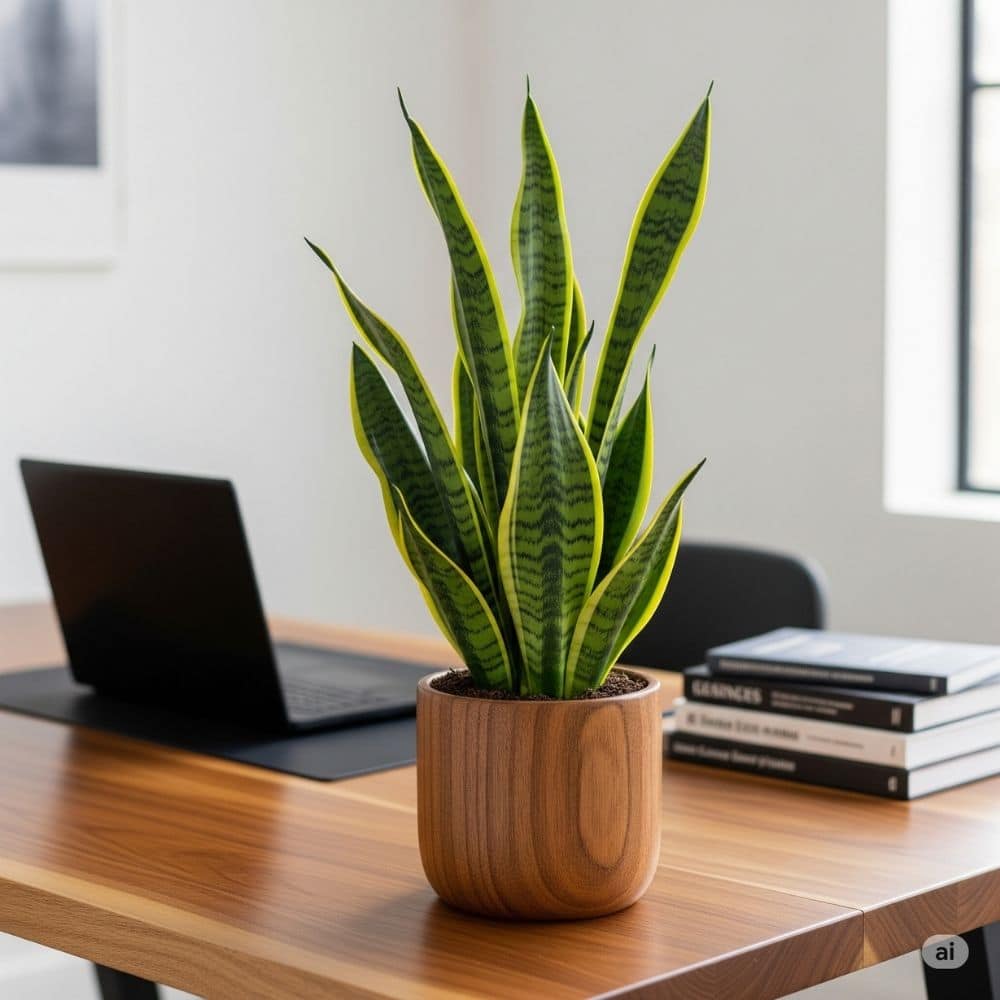Meet The Snake Plant
Snake Plant: Your Super Easy, Super Stylish Green Buddy… Ever wished for a plant that’s almost impossible to kill, looks incredibly chic, and even helps clean your air? Well, meet the Snake Plant! This amazing green friend, scientifically known as Sansevieria trifasciata (though botanists recently reclassified it into the Dracaena family!), is a true superstar for anyone, from total beginners to seasoned plant parents.
With its striking, upright, sword-like leaves, the Snake Plant adds an instant touch of modern elegance to any room. Plus, it’s famous for being incredibly tough and forgiving. Ready to discover why this resilient beauty is a must-have for your home? Let’s dig in!
What Makes a Snake Plant So Unique?
When you look at a Snake Plant, you can’t help but notice its bold, upright leaves. They really do look like sturdy swords reaching for the sky! These leaves are often a deep green, but many varieties boast cool patterns, stripes, or even yellow edges. They have a slightly waxy feel and just stand so elegantly, giving your space an instant modern vibe. What’s more, the Snake Plant grows pretty slowly, meaning it keeps its perfect shape for a long time. It’s like living art that rarely needs fussing over!
Where Do Snake Plants Come From? Africa’s Hardy Survivor
Believe it or not, your snake plant ancestors originally come from the dry, rocky regions of West Africa, stretching from Nigeria all the way to the Congo. Imagine surviving in places where water is scarce and conditions are tough! This background is exactly why they’re so incredibly drought-tolerant and easy to care for in our homes. They’re true survivors, built to thrive even when you forget to water them for a bit.
What Are Its Other Names? “Mother-in-Law’s Tongue” and More
The Snake Plant has a few popular nicknames! The most famous, or infamous, is “Mother-in-Law’s Tongue” – probably because of its sharp, pointed leaves and how tough it is! You might also hear it called “Viper’s Bowstring Hemp” due to its fibrous leaves traditionally being used to make bowstrings. Whatever you call it, its unique look and hardy nature are what truly make it stand out.
Snake Plants Varieties

While they all share that iconic upright leaf shape, Snake Plants actually come in a surprising variety of looks!
Popular Snake Plant Varieties: From Classic to Trendy
- ***Sansevieria trifasciata ‘Laurentii’***: This is the classic beauty you’ll most often see, famous for its dark green leaves with distinct yellow edges. It’s a timeless choice.
- ***Sansevieria trifasciata ‘Zeylanica’***: This one has lovely green leaves with lighter, mottled green bands, giving it a more subtle, organic look.
- Sansevieria cylindrica: Super cool and architectural, this variety has long, round, spear-like leaves that grow straight up. It looks very modern and unique.
- ***Sansevieria trifasciata ‘Moonshine’***: A real standout with stunning silvery-green leaves that have just a hint of dark green banding. It almost glows in the right light!
- ***Sansevieria trifasciata ‘Black Coral’***: Features very dark green leaves with lighter, almost black horizontal bands, giving it a dramatic, sophisticated appearance.
Leaf Looks: Colors, Patterns, and Shapes
The diversity in Snake Plant leaves is quite impressive! You’ll find them in various shades of green, from deep forest green to pale silvery hues. Many have beautiful variegation – those cool stripes, spots, or distinct edges in yellow, white, or lighter green. And while most are flat and sword-like, varieties like Sansevieria cylindrica offer a completely different, cylindrical shape.
Size Variations: From Desk-Sized to Floor-Standing
Whether you need a tiny plant for your desk or a towering statement piece for your living room floor, there’s a Snake Plant for you. Some varieties stay quite compact, perfect for small spaces, while others can grow impressively tall, adding serious vertical interest.
How Do You Take Care of Your Snake Plant?

Here’s the best part: caring for a Snake Plant is so simple, it almost feels like cheating! They’re incredibly forgiving, making them perfect for busy people or anyone just starting their plant journey.
For a more comprehensive guide to Snake Plant Care, you can review our article on “Snake Plant Care”.
The Right Light: Adaptable, But Loves Bright Indirect Light
Your Snake Plant is a true survivor when it comes to light. It can actually tolerate pretty low light conditions, which is why you often see them in offices or dim corners. However, for it to truly thrive and grow its best, it loves bright, indirect light. Think of a spot near a window that gets plenty of brightness but no harsh direct sun beating down on its leaves – that can cause sunburn!
Watering Smart: Less is Definitely More!
This is the golden rule for Snake Plants: always let the soil dry out completely between waterings. Because they store water in their leaves and roots, they really, really hate sitting in soggy soil. Overwatering is the number one killer of Snake Plants, leading to mushy, yellow leaves and root rot. When you do water, do it thoroughly until water drains out the bottom, then wait until the soil is bone dry again before the next drink. You can cut back on watering even more during the cooler winter months when the plant is less active.
Cozy Temperatures and Low Humidity, Please!
Snake Plants are happy in average room temperatures, generally between 65-80°F (18-27°C). They’re not fans of cold drafts, so try to keep them away from chilly windows or vents in winter. As for humidity, they’re super adaptable and don’t need high humidity at all – average indoor humidity is perfectly fine for them. No need for humidifiers here!
Choosing the Right Soil and Pot: Drainage is Key!
Since they hate wet feet, your Snake Plant needs well-draining soil. A cactus and succulent potting mix is absolutely perfect for them. If you’re using standard potting soil, add some perlite or sand to enhance drainage. Also, make sure to always use a pot that has drainage holes! These plants actually prefer to be a little bit snug in their pots, so you won’t need to repot them very often – maybe every 2-5 years, or when they’re bursting out of their container.
Feeding Your Snake Plant: Light Meals Are Best
Snake Plants aren’t very hungry! You only need to fertilize them sparingly during their active growing season (spring and summer). Use a balanced liquid houseplant fertilizer, diluted to half strength, just once a month or even less frequently. There’s no need to fertilize at all during the fall and winter.
What Are Common Problems with Snake Plants and How to Fix Them?
Even though they’re incredibly tough, Snake Plants can sometimes show you they’re unhappy. Here’s what you should watch for and ways you can help:
Yellowing or Mushy Leaves: Usually Overwatering
This is by far the most common problem! If your Snake Plant’s leaves are turning yellow, getting soft, or feeling mushy, it’s almost always a sign of overwatering and probably root rot.
- The Fix: Immediately stop watering! Let the soil dry out completely. If it’s really bad, you might need to gently take the plant out of its pot, check the roots for mushy spots (and trim them off), and repot into fresh, dry, well-draining soil.
Brown Tips or Dry Spots: Can Be Underwatering or Sunburn
While rare, if your leaves have brown, crispy tips or dry spots, it could be very slight underwatering (you’ve really let it get parched!) or, less likely, too much direct, harsh sunlight burning the leaf.
- The Fix: Adjust your watering schedule slightly if it’s consistently bone dry for too long. And move it out of any intense direct sun.
Leggy or Pale Growth: Not Enough Light
If your Snake Plant starts looking thin, stretched out, or its vibrant colors seem to fade and look pale, it’s telling you it needs more light.
- The Fix: Move it to a brighter spot with indirect light. Keeping the plant in low light won’t harm it, but it also won’t allow the plant to look its best.
Pests: Rarely an Issue, But Watch Out!
Good news! Snake Plants are pretty resistant to pests. But occasionally, if conditions are right, you might see common houseplant pests like mealybugs or spider mites.
- The Fix: Regularly check your plant. If you spot any tiny invaders, wipe them off with a damp cloth or treat them with insecticidal soap.
Root Rot: The Silent Killer
This is the big one that stems from overwatering. Root rot causes the roots to literally rot away, preventing the plant from taking up water and nutrients.
- The Fix: Preventing problems is essential—make sure the drainage is excellent and allow the soil to dry out fully between waterings. If you suspect it, you’ll need to check the roots as mentioned above.
Is the Snake Plant Toxic? Safety for Pets
This is a very important question, especially for pet parents! Please know that Snake Plants (all Sansevieria species) are considered mildly toxic if ingested. They contain little crystals called calcium oxalates, which can cause irritation.
If your cats, dogs, or other pets decide to chew on a Snake Plant, you might see symptoms like:
- Oral pain and irritation: They might paw at their mouth or drool more than usual.
- Vomiting: Especially if they’ve eaten a noticeable amount.
- Diarrhea: Due to digestive upset.
- Loss of appetite: Because their mouth might be uncomfortable.
While usually not life-threatening, it can be very uncomfortable for your furry friends. So, it’s highly recommended to keep Snake Plants out of reach of curious pets and small children. If you think your pet has eaten any part of a Snake Plant and shows symptoms, it’s always best to contact your veterinarian right away for advice.
Snake Plant for Your Home Decor: Modern Style and Versatility

The Snake Plant is an interior designer’s dream! Its unique look and easy-going nature make it incredibly versatile for styling your home:
Creating a Modern Minimalist Look
With its sleek, upright form and clean lines, the Snake Plant effortlessly fits into modern, minimalist, and even industrial decor styles. It brings an element of elegance while keeping the space uncluttered.
Enhancing Vertical Space and Visual Interest
Got a narrow corner or an empty spot that needs a little height? The Snake Plant is perfect! Its upward growth adds fantastic vertical interest, making rooms feel taller and more dynamic.
Brightening Up Any Room (Even Low Light Ones!)
Because it’s so adaptable to different light levels, you can place a Snake Plant almost anywhere in your home. It’s perfect for adding life to those spots where other plants just won’t make it, brightening up even a low-light room.
A Clean Air Champion
Beyond its good looks, the Snake Plant is also a fantastic air purifier! It was famously part of NASA’s Clean Air Study, known for its ability to filter out common indoor toxins like formaldehyde, benzene, and trichloroethylene. Additionally, it’s among the rare plants that release oxygen during the night, which makes it an excellent option for bedrooms.
The Charm of Snake Plants: Tough, Timeless, and Terrific
The Snake Plant is genuinely a standout among houseplants. It offers an unbeatable combination of effortless care, incredible resilience, and a stylish, timeless look. Whether you’re a busy bee, a new plant parent, or just someone who loves a plant that gives more than it asks for, the Snake Plant is your perfect green companion. It’s a testament to nature’s toughness, bringing beauty, fresh air, and peace of mind into your home for years to come. You may also be interested in our article on “The benefits of Snake Plant“.
Frequently Asked Questions (FAQ) About Snake Plants
Still have some questions about your awesome Snake Plant? Here are a few typical ones you might encounter!
Q1: How often should I water my Snake Plant?
A1: Water only when the soil has completely dried out! This is super important. Depending on light and temperature, this could be every 2-4 weeks in summer, and even less often in winter (sometimes just once a month!).
Q2: Why are my Snake Plant leaves turning yellow and mushy?
A2: This is almost always a sign of overwatering. The plant is receiving excessive water, causing its roots to begin rotting. Stop watering immediately, let the soil dry out, and ensure your pot has excellent drainage.
Q3: Does my Snake Plant need a lot of light?
A3: Not really! Snake Plants are very adaptable to low light, but they thrive and look their best in bright, indirect light. Steer clear of exposing them to direct, intense sunlight, since it can burn their leaves.
Q4: Is the Snake Plant really good for purifying air?
A4: Yes! It’s famous for it. Snake Plants are highly effective at filtering out common air toxins such as formaldehyde and benzene. They even release oxygen at night, which is a nice bonus for your bedroom!
Q5: How fast do Snake Plants grow?
A5: Snake Plants are generally slow growers. Don’t expect rapid new leaves! Their slow and steady pace is part of their low-maintenance charm, allowing them to keep their elegant form for a long time.
Q6: Can I put a Snake Plant in my bedroom?
A6: Absolutely! They’re actually a fantastic choice for bedrooms because they release oxygen at night, contributing to better air quality while you sleep. Simply make sure to keep them away from pets if you have any.
Q7: How do I propagate a Snake Plant?
A7: They’re quite easy to propagate! You can take a leaf cutting (cut a section about 2-4 inches long), let it callous for a few days, then place it in water or directly into well-draining soil. You can also divide the plant from its rhizomes when repotting.
Q8: Why do my Snake Plant’s leaf tips turn brown and crispy?
A8: Brown, crispy tips are often a sign of underwatering (if the soil is consistently bone dry for too long) or sometimes too much direct sunlight. They can also occur from too many dissolved salts in tap water, so using filtered water can help.
Q9: What’s the best soil for a Snake Plant?
A9: The best soil is a well-draining mix, typically a cactus and succulent potting mix. This stops water from accumulating around the roots, which is essential for keeping them healthy. If using regular potting soil, make sure to add extra perlite for drainage.





